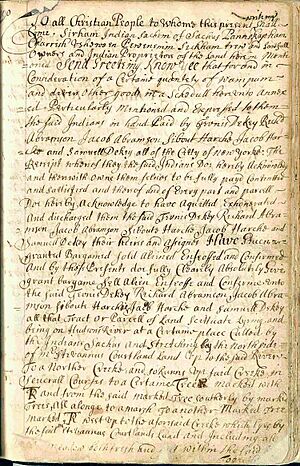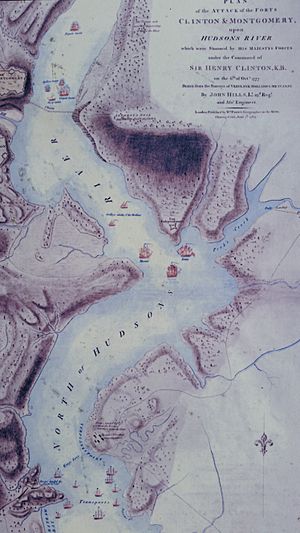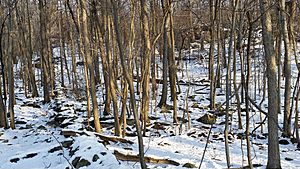Peekskill, New York facts for kids
Quick facts for kids
Peekskill, New York
|
||
|---|---|---|
| City of Peekskill | ||
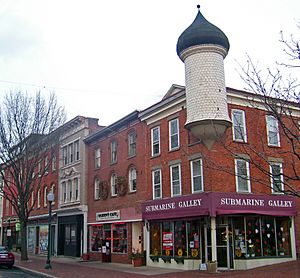
Downtown Peekskill
|
||
|
||
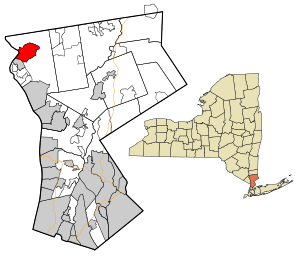
Location in Westchester County and New York
|
||
| Country | ||
| State | ||
| County | Westchester | |
| Incorporated (village) | 1816 | |
| Incorporated (city) | 1940 | |
| Government | ||
| • Type | Council-Manager | |
| Area | ||
| • Total | 5.57 sq mi (14.43 km2) | |
| • Land | 4.34 sq mi (11.25 km2) | |
| • Water | 1.23 sq mi (3.18 km2) | |
| Elevation | 128 ft (39 m) | |
| Population
(2020)
|
||
| • Total | 25,431 | |
| • Density | 5,854.28/sq mi (2,260.30/km2) | |
| Time zone | UTC-5 (Eastern (EST)) | |
| • Summer (DST) | UTC-4 (EDT) | |
| ZIP Code |
10566
|
|
| Area code(s) | 914 | |
| FIPS code | 36-56979 | |
| GNIS feature ID | 0960097 | |
Peekskill is a city in northwestern Westchester County, New York, United States. It is about 35 miles (56 km) north of New York City. The city was first set up as a village in 1816. It became a city in 1940. Peekskill sits on a bay along the east side of the Hudson River. Across the river is Jones Point in Rockland County.
In 2020, about 25,431 people lived in Peekskill. This was more than the 23,583 people counted in 2010. It is the third-largest town in northern Westchester County. Only Cortlandt and Yorktown are larger.
Peekskill was an early center for industry in America. It was known for making iron plows and stoves. The Binney & Smith Company, which makes Crayola products, has ties to Peekskill. Joseph Binney started the Peekskill Chemical Company here in 1864. His son Edwin and nephew Harold Smith later formed a partnership in 1885.
In 1949, there were some well-known events called the Peekskill Riots. These happened during concerts by Paul Robeson to support civil rights. There were conflicts and protests, especially after a concert in September. Even so, Peekskill has had several African American mayors since 1984.
Contents
History of Peekskill
Early Days and Native Americans
In September 1609, an English explorer named Henry Hudson anchored his ship, the Half Moon, near Peekskill. His first mate wrote in the ship's log that it was a "very pleasant place to build a town." Later, a resident of New Amsterdam named Jan Peeck met the Lenape people who lived here. This area was known as "Sachoes."
The exact date is not clear, but agreements and trading happened. These were made official in a document called the Ryck's Patent Deed on April 21, 1685.
The name Peekskill comes from Jan Peeck's last name and the Dutch word kil or kill, which means stream.
The Sachoes Village
We don't know much about the Sachoes village or where they came from. Some people believe the tall pine trees they lived among were not native to the area. This suggests the Native Americans might have brought and planted them.
The last known chief (Sachem) of the Sachoes when the Ryck's Patent was signed was named Sirham. After trading with Jan Peeck for a long time, the Sachoes started calling the creek where he traded "John Peek's Creek." This is likely how the city got its name.
Other names for the area, like Sachus, Sackhoes, and Sackock, mean "at the mouth or outlet of a creek or river." Their land stretched from Magregere's Brook to Dickey Brook. Sachus is thought to be the first Sachem of the Sachoes. This name can mean "black kettle." After the patent was signed, parts of the area stayed wild. The Native Americans lived throughout the section until about 1742.
Revolutionary War Times
On the north side of Annsville Creek, where it meets the Hudson River, was Fort Independence. This fort, along with Forts Montgomery and Clinton, helped protect the Hudson River Valley. Fort Independence was built in August 1776. Fort Hill Park, where Camp Peekskill was located, had five barracks and two small forts (redoubts).
Settlement was slow in the early 1700s. But by the time of the American Revolution, Peekskill was an important place for making things. This made it a good spot for the Continental Army, which set up an outpost here in 1776. Several creeks and streams powered mills that made gunpowder, leather, wood planks, and flour. Slaughterhouses provided fresh meat. These supplies could easily be sent from the docks along the river. Many supplies were needed to support other forts that protected the Hudson River Chains. These chains were placed between Bear Mountain Bridge and Anthony's Nose to stop British ships from sailing up the river.
Even though Peekskill's land and mills helped the American side, they also made it a target for British attacks. The worst attack happened in early spring of 1777. A force of British ships and soldiers took over the American defenses. In June 1781, George Washington briefly stayed in Peekskill.
After the Revolution
Peekskill officially became a village in 1816. Village elections took place in 1826. It was part of the Town of Cortlandt until it became its own city in 1940.
In 1859, Henry Ward Beecher, a famous minister, bought a farm in Peekskill. He made many improvements and used it as a summer home. In 1902, the McFadden family bought the property. In 1987, the Beecher-McFadden Estate was added to the National Register of Historic Places.
A piece of the Peekskill Meteorite landed in Peekskill just before midnight on October 9, 1992. At least 16 people filmed the meteor as it streaked across the sky. This was only the fourth time in history that a meteorite's exact path was known. The rock weighed about 27.7 pounds (12.6 kg). It even went through the trunk of a car when it hit!
In 1984, Richard E. Jackson became Peekskill's first African American mayor.
Geography of Peekskill
Peekskill is located at 41.2889 degrees north latitude and -73.9200 degrees west longitude. This is in northwestern Westchester County.
The city covers about 5.5 square miles (14.2 square kilometers). Of this, about 4.3 square miles (11.1 square kilometers) is land, and 1.1 square miles (2.8 square kilometers) is water. The eastern side of the city borders the Town of Cortlandt. The western side borders the Hudson River.
People of Peekskill
| Historical population | |||
|---|---|---|---|
| Census | Pop. | %± | |
| 1870 | 6,560 | — | |
| 1880 | 6,893 | 5.1% | |
| 1890 | 9,676 | 40.4% | |
| 1900 | 10,358 | 7.0% | |
| 1910 | 15,245 | 47.2% | |
| 1920 | 15,868 | 4.1% | |
| 1930 | 17,125 | 7.9% | |
| 1940 | 17,311 | 1.1% | |
| 1950 | 17,731 | 2.4% | |
| 1960 | 18,737 | 5.7% | |
| 1970 | 19,283 | 2.9% | |
| 1980 | 18,236 | −5.4% | |
| 1990 | 19,536 | 7.1% | |
| 2000 | 22,441 | 14.9% | |
| 2010 | 23,583 | 5.1% | |
| 2020 | 25,431 | 7.8% | |
| U.S. Decennial Census | |||
In 2010, there were 23,583 people living in Peekskill. The population was made up of different groups:
- 35.8% White
- 21.4% Black
- 2.9% Asian
- 36.9% were Hispanic or Latino (of any race).
In 2020, the American Community Survey showed that 13.8% of the city's population was Ecuadorian. Also, 10.4% were Puerto Rican, and 4.9% were Guatemalan.
The average household in Peekskill had about 2.55 people. The average family had about 3.18 people.
Arts and Culture
Peekskill has many places for art and culture.
- The Paramount Hudson Valley Theater is a restored movie palace from the 1930s. It offers music, comedy, plays, and independent films.
- STUDIO No.9 Gallery and Workshops is a place for art.
- The Peekskill Coffee House often features local performers.
- The Bean Runner Cafe and 12 Grapes also showcase local artists and musicians.
The Hudson Valley Museum of Contemporary Art (Hudson Valley MOCA) has a large exhibition space. It also has a program where artists can live and work there.
Media
WLNA 1420 AM is a local radio station that has served Peekskill since 1948.
Parks and Recreation
The city has several parks and places for fun:
- Charles Point offers great views of the bay and river.
- Depew Park has pools, a pond, ballfields, and trails. It's also where the Recreation Department is located.
- Other parks include Franklin Park, Lepore Park, Fort Hill Park, Peekskill Dog Park, Peekskill Stadium, Riverfront Green Park, and Tompkins Park (home of Little League).
Education
Schools in Peekskill
The Peekskill City School District serves the entire city. Peekskill High School is the main high school.
The Roman Catholic Archdiocese of New York runs Catholic schools in Westchester County. Our Lady of the Assumption School in Peekskill closed in 2013. The closest Catholic school now is St. Columbanus School in Cortlandt Manor.
Healthcare
Peekskill is served by New York Presbyterian – Hudson Valley Hospital. It was founded in 1889 as Peekskill Hospital. In 2014, it became part of New York-Presbyterian Hospital.
The hospital has 128 beds for patients. It includes a cancer center, a maternity center, a special care unit for newborns, and a surgery center.
The city also has an emergency medical service. It is staffed by EMTs and paramedics from the city's fire department and volunteer ambulance corps. Most patients are taken to NYP-Hudson Valley Hospital.
Transportation
The Peekskill train station offers train service to New York City, which is about 41 miles (66 km) away. This service is provided by Metro-North Railroad. The Bee-Line Bus System also provides bus service within Peekskill.
The Bear Mountain Bridge, about 5 miles (8 km) northwest, connects Peekskill to Bear Mountain State Park across the Hudson River. It also leads to the Palisades Interstate Parkway and the United States Military Academy at West Point. The Croton Expressway part of US 9 ends here. NY 9A and NY 35 also pass through the city.
Notable People from Peekskill
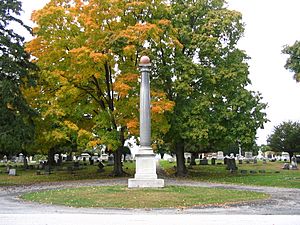
Many interesting people have connections to Peekskill:
- Hilton Armstrong and Elton Brand are professional basketball players who graduated from Peekskill High School. Elton Brand is now a General Manager for the Philadelphia 76ers.
- Reggie Austin is an actor born in Peekskill.
- Peter Bagge is a well-known cartoonist who grew up in Peekskill.
- Becca Balint, a Congresswoman for Vermont, was raised here.
- Henry Ward Beecher was an important minister during the Civil War era.
- T. C. Boyle is a novelist and used to live in Peekskill.
- Benjamin Civiletti was a former United States Attorney General.
- Chauncey Depew was a chairman of the New York Central Railroad and a U.S. senator.
- Abel Ferrara is an independent filmmaker who grew up in Peekskill.
- Mel Gibson is a famous actor, director, and producer who was born in Peekskill.
- Jackie Gleason, the actor and comedian, lived in Peekskill for a few years.
- James William Husted was a U.S. Representative.
- Richard E. Jackson was Peekskill's first African-American mayor.
- Tre Johnson was an NFL football player who graduated from Peekskill High School.
- Malcolm Koonce is an NFL Defensive End for the Las Vegas Raiders.
- Sean Murphy is an MLB catcher for the Atlanta Braves.
- George Pataki, a former New York Governor, was born in Peekskill and served as its mayor.
- Paul Reubens, known as Pee-wee Herman, was an entertainer.
- Stanley Tucci is an actor who was born in Peekskill.
See also
 In Spanish: Peekskill para niños
In Spanish: Peekskill para niños



